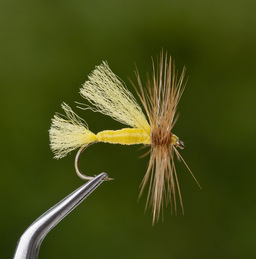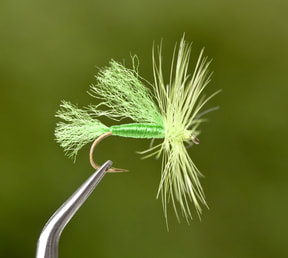Fly of the Month 07.13
Little Green Stonefly
Chloroperlidae (family) Green Stoneflies
(see the article Little Yellow Stonefly)
Little Green Stonefly
Chloroperlidae (family) Green Stoneflies
(see the article Little Yellow Stonefly)
Fly of the Month 07.13
Little Yellow Stonefly
Most stoneflies in the East are primarily seen by anglers in the nymph form while rolling a rock over. The is due to the larger Salmonfly and Golden Stonefly hatches being nocturnal or at least very late-evening and rarely witnessed during the day. During the winter months the Little Black Stone and the Early Brown Stone may be seen as sparse hatches during the day but only by the few anglers that venture out in the cold.
There is no wonder why we use a Black Stone, Brown Stone or Golden Stone nymph fly pattern. Trout feed on these larger stonefly nymphs whenever possible, so these fly patterns can be very productive. However, this successful nymphing does beg the question as to when do you fly fish with the dry fly pattern of a stonefly.
Little Green Stonefly
and Little Yellow Stonefly
During the summer months, especially on the South Toe River and comparable freestone streams, there are small stoneflies hatching in relative abundance in our North Carolina streams. Specifically:
Isoperlidae (family) Green-Winged Stoneflies
Isoperla Body greenish or yellowish, wings usually greenish
Kathroperla Yellow Sally (summertime stone pattern) - green and tan also
Chloroperlidae (family) Green Stoneflies
It is not necessary to know these scientific names. But it is important to know that two colors of stoneflies appear during the summer months.
The first and primary hatch may be tannish-yellow to a very pale greenish-yellow in color but is mostly imitated as yellow and with a fly pattern such as the Size 16 or Size 18 Yellow Sally, Yellow Palmer, Yellow Stimulator or Yellow Elk Hair Caddis.
The second hatch which often follows later in the day is insect green to pale-green in color. A Size 16 or Size 18 Insect Green Palmer, Insect Green Stimulator or Insect Green Elk Hair Caddis may be used for the imitation.
Since most trout streams in North Carolina have trout that are very opportunistic, the actual fly pattern and precise color is not necessary. However, there are times when the hatches are in such numbers that the trout become selective. During those times, it is best to have a more precise fly pattern such as the following:
Two stonefly dry flies are featured in Roger Lowe’s Fly Pattern Guide to the Great Smoky Mountains. Roger’s:
Little Green Stonefly caption “A mid-summer fly; hatches in less quantity than Little Yellow Stone”
Little Yellow Stonefly caption “Hatches May to late summer; found on nearly every stream in the Smokies; this hatch extends over a longer period of time than any other hatch in the Southern Appalachia”
This is a fly pattern that could be tied with a lot of variations but we present the recipes as recommended by Roger Lowe. He has had great success with these two fly patterns.
Fly (Flies) of the Month 7.14 Little Green Stonefly and Little Yellow Stonefly
HOOK : Tiemco 100, size 12,14,16,18
THREAD : Uni 8/0 color to match body
TAIL : Poly Yarn
WING : Poly Yarn
ABDOMEN : Poly Yarn
HACKLE : Dry Rooster
1. Begin by wrapping the hook from the eye to the hook bend with tight touching wraps returning to one third back from the eye, and let the bobbin hang.
2. Select a three inch piece of poly yarn and separate into one third and two thirds. Taking the two thirds portion, hold by the tip and comb through to separate and straighten fibers. Trim one end to square and tie in at one third back from the eye. Taking tight, touching turns of thread, advance to the hook bend and secure with two wraps. Trim the tail to one third the length of the shank. Advance the thread to one third back from the eye in open, rapid turns. Do not build up anymore than necessary. Let the bobbin hang.
3. Take the one third section of poly yarn and repeat the comb process. Tie in the poly and take the thread in tight turns back to the tail, wrapping the poly on top of the shank. Advance the thread in open turns again, and let the bobbin hang.
4. Wrap the poly yarn in tight, slightly overlapping turns to the two thirds mark. Overlapping will build a tapered body. Tie off and trim excess. Let the bobbin hang.
5. Select a rooster hackle, trimming the barbs back three eights inches back and tie in with the “shiny” side facing the eye. Advance the hackle in tight, touching turns to two eyelengths from the eye and tie off. Trim the waste hackle and form a small head with thread. Complete the fly with a whip finish and cement the head.
- Tom Adams, Alen Baker
Little Yellow Stonefly
Most stoneflies in the East are primarily seen by anglers in the nymph form while rolling a rock over. The is due to the larger Salmonfly and Golden Stonefly hatches being nocturnal or at least very late-evening and rarely witnessed during the day. During the winter months the Little Black Stone and the Early Brown Stone may be seen as sparse hatches during the day but only by the few anglers that venture out in the cold.
There is no wonder why we use a Black Stone, Brown Stone or Golden Stone nymph fly pattern. Trout feed on these larger stonefly nymphs whenever possible, so these fly patterns can be very productive. However, this successful nymphing does beg the question as to when do you fly fish with the dry fly pattern of a stonefly.
Little Green Stonefly
and Little Yellow Stonefly
During the summer months, especially on the South Toe River and comparable freestone streams, there are small stoneflies hatching in relative abundance in our North Carolina streams. Specifically:
Isoperlidae (family) Green-Winged Stoneflies
Isoperla Body greenish or yellowish, wings usually greenish
Kathroperla Yellow Sally (summertime stone pattern) - green and tan also
Chloroperlidae (family) Green Stoneflies
It is not necessary to know these scientific names. But it is important to know that two colors of stoneflies appear during the summer months.
The first and primary hatch may be tannish-yellow to a very pale greenish-yellow in color but is mostly imitated as yellow and with a fly pattern such as the Size 16 or Size 18 Yellow Sally, Yellow Palmer, Yellow Stimulator or Yellow Elk Hair Caddis.
The second hatch which often follows later in the day is insect green to pale-green in color. A Size 16 or Size 18 Insect Green Palmer, Insect Green Stimulator or Insect Green Elk Hair Caddis may be used for the imitation.
Since most trout streams in North Carolina have trout that are very opportunistic, the actual fly pattern and precise color is not necessary. However, there are times when the hatches are in such numbers that the trout become selective. During those times, it is best to have a more precise fly pattern such as the following:
Two stonefly dry flies are featured in Roger Lowe’s Fly Pattern Guide to the Great Smoky Mountains. Roger’s:
Little Green Stonefly caption “A mid-summer fly; hatches in less quantity than Little Yellow Stone”
Little Yellow Stonefly caption “Hatches May to late summer; found on nearly every stream in the Smokies; this hatch extends over a longer period of time than any other hatch in the Southern Appalachia”
This is a fly pattern that could be tied with a lot of variations but we present the recipes as recommended by Roger Lowe. He has had great success with these two fly patterns.
Fly (Flies) of the Month 7.14 Little Green Stonefly and Little Yellow Stonefly
HOOK : Tiemco 100, size 12,14,16,18
THREAD : Uni 8/0 color to match body
TAIL : Poly Yarn
WING : Poly Yarn
ABDOMEN : Poly Yarn
HACKLE : Dry Rooster
1. Begin by wrapping the hook from the eye to the hook bend with tight touching wraps returning to one third back from the eye, and let the bobbin hang.
2. Select a three inch piece of poly yarn and separate into one third and two thirds. Taking the two thirds portion, hold by the tip and comb through to separate and straighten fibers. Trim one end to square and tie in at one third back from the eye. Taking tight, touching turns of thread, advance to the hook bend and secure with two wraps. Trim the tail to one third the length of the shank. Advance the thread to one third back from the eye in open, rapid turns. Do not build up anymore than necessary. Let the bobbin hang.
3. Take the one third section of poly yarn and repeat the comb process. Tie in the poly and take the thread in tight turns back to the tail, wrapping the poly on top of the shank. Advance the thread in open turns again, and let the bobbin hang.
4. Wrap the poly yarn in tight, slightly overlapping turns to the two thirds mark. Overlapping will build a tapered body. Tie off and trim excess. Let the bobbin hang.
5. Select a rooster hackle, trimming the barbs back three eights inches back and tie in with the “shiny” side facing the eye. Advance the hackle in tight, touching turns to two eyelengths from the eye and tie off. Trim the waste hackle and form a small head with thread. Complete the fly with a whip finish and cement the head.
- Tom Adams, Alen Baker


